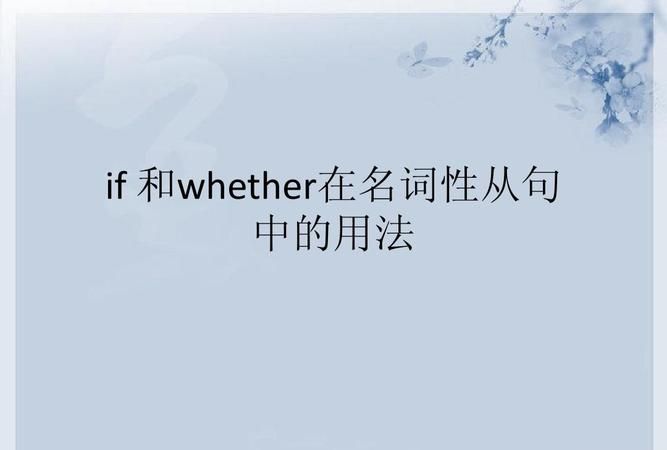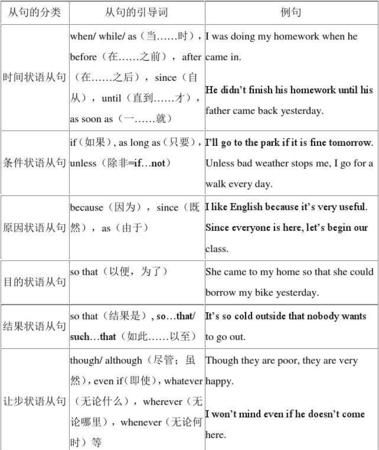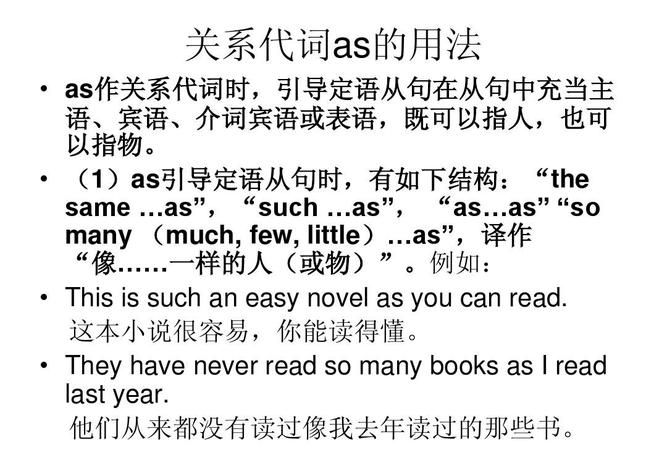本文目录
从句是什么
用一个句子来做句子成分,这个句子就叫做从句!
用一个句子做主语,这个句子叫做主语从句。
用一个句子做宾语,这个句子叫做宾语从句。
用一个句子做定语,这个句子叫做定语从句。
用一个句子作状语,这个句子叫做状语从句。
例子:
1] [That I made friends with Mr. Whya ] made him surprised
这个句子做主语,叫做主语从句。
主语从句表示所做过的某件事等
意思:我跟为什么啊先生交朋友[这件事情]使得他很惊讶。
2] He knows [that I made friends with a Mr. Whya.]
这个句子做宾语,叫做宾语从句。
宾语从句也表示做过的一件事等。
意思:他知道我跟为什么啊先生交朋友[这件事]了。
3] The reason is [that I made friends with Mr. Whya]
这个句子做表语,叫做表语从句。
动词be [am, is, are, was, were]后面的句子就叫做表语从句。
意思:原因就是我跟为什么啊先生交朋友了。
4] They reason [why I made friends with Mr. Whya] is funny
这个用why引导的句子做定语,修饰reason,叫做定语从句。
意思:我跟为什么啊先生交朋友的原因很滑稽可笑。
5] He got angry when I made friends with Mr. Whya
这个用when引导的句子,叫做状语从句,表示时间
意思:当我跟为什么啊先生交朋友的时候,他愤怒了。

什么叫从句英语
由两个或两个以上的有主谓结构的句子用从属连词连接起来的句子。其中一个句子是主体,叫做主句,而其他的句子叫做从句。
从句由连接词引导, 它们是: that, before, whether, if, although, because, as long as, as soon as, since, after, who, which, whom, what, whose, why, where, how, when。
从句尽管有主谓结构,但不能单独成为一个句子,在句中, 从句仅担任某个成分,根据担任的成分从句可分主语从句,宾语从句,表语从句,定语从句,状语从句。
主语从句 在句中起主语作用的句子叫做主语从句.
主语从句一般放在句首。引导主语从句的词有: that, who, whether, if, what, which, when, where, how, why.
What he said is not true. 他说的不是实话.
宾语从句 在句中起宾语作用的句子叫做宾语从句,宾语从句放在动词后面。
引导宾语从句的词有下列。that, if, whether, what, which, when, where, how, why。
Could you tell me who is your teacher? 你能告诉我谁是你的教师吗?
表语从句 在句中起表语作用的句子叫做表语从句,表语从句放在系动词的后面。
引导表语从句的词有下列。that, if, whether, what, which, when, where how, why等。
That is why I am late. 这就是我为什么迟到。
定语从句 在句中起定语作用的句子叫做定语从句,定语从句放在被修饰的名词后面。
引导定语从句的词有下列。who, whose, that, which, whom, when, where why.
That is the reason why he lost his job. 这就是他为什么失去工作的原因。
状语从句 在句中起状语作用的句子叫做状语从句,状语从句一般放在句后,强调时放在句首。
I'll let you know as soon as he come back. 他一回来我就告诉你。
I won’t leave until Mum comes back. 妈妈回来了我才会走。

宾语从句谓语从句定语从句的区别
首先没有谓语从句这一说,有宾语从句,表语从句,主语从句,定语从句,同位语从句,状语从句——举个例子,宾语从句就是指,充当宾语的这个部分是一个句子,就是宾语从句,eg,I know she is right.我知道她是正确的。I为主语, know为谓语, she is right是一个句子,放在动词know(也就是谓语)后面做宾语,因为是个句子,故叫宾语从句。

从句是什么意思?
在英语中 简单的说:
当一个句子充当句中的成分时,就叫做该成分的从句.
比如一个句子做主语,那么就叫主语从句;
比如一个句子做宾语,那么就叫宾语从句;
比如一个句子做定语,那么就叫定语从句;
比如一个句子做状语,那么就叫状语从句;
比如一个句子做表语,那么就叫表语从句;
比如一个句子做同位语,那么就叫同位语从句 句子成分(主谓宾定状补)通常都是单词,这样的句子叫简单句.
如果句子里用另外一个句子做句子成分,那就是一个复杂句,而做成分的句子就叫做从句.
i saw him.这里主谓宾都是单词,是简单句
i saw that he was singing.
主句是I 谓语是saw 宾语是"that he was singing."这个句子,而这个句子就叫宾语从句.
与这个相似的还有,主语从句,定语从句,表语从句,状语从句等.
另外to normanjl:不要误导呀,从句是充当句子成分,而不是修饰句子成分.比如主语从句,宾语从句,同位语从句,表语从句.都不起修饰的作用.只有定语从句和状语从句才起修饰句子成分或句子的作用.
从句不能单独成立的说法也是错的,从句自己就是一个完整的句子.去掉导引词后是完全可以单独成立的.甚至有的从句根本就没有引导词. 宾语从句 用一个句子作宾语就是宾语从句.
如:Nobody knew (whether he could pass the exam.) 没有人知道他是否会通过考试.
He told me (that he would go to college the next year.) 他告诉我他明年上大学.
Do you know (who has won Red Alert game?) 你知道是谁赢得了红色警戒的游戏么?
He didn’t tell me (when we should meet again. )他没有告诉我什么时候我们能再见面.
括号括着的都是宾语从句 定语从句 what 不能引导定语从句,可引导主语从句,表语从句,宾语从句; it 只是个代词,不能引导从句.
where(先行词是地点):I live in a beautiful city where I was born.
which(先行词是物):I live in a beautiful city in which I was born.
where = 介词+ which
that(先行词是人或物):I live in leshan that(可用which) is a beautiful city.
who(先行词是人,做从句的主语或宾语):I know this man who(可用that) are standing under the tree.
whom(先行词是人,做从句宾语):I know this man whom the manager fired yesterday. 主语从句 在复合句中充当主语的句子叫做主语从句.
It is certain that he will win the match.
Whom we must study for is a question of great importance 状语从句 状语从句
(Adverbial Clause)
一 状语从句的种类
§ 1状语从句的种类
用来修饰谓语动词、其它动词、定语、状语或整个句子的从句叫做状语从句.状语从句可分为:
1.时间状语从句;(adverbial clause of time)
2.地点状语从句;(adverbial clause of place)
3.原因状语从句;(adverbial clause of cause)
4.条件状语从句;(adverbial clause of condition)
5.目的状语从句;(adverbial clause of purpose)
6.让步状语从句;(adverbial clause of concession)
7.比较状语从句;(adverbial clause of comparison)
8.程度状语从句;(adverbial clause of degree)
9.方式状语从句;(adverbial clause of manner)
10.结果状语从句.(adverbial clause of result)
§2状语从句的时态特点
一般情况下,时间和条件状语从句的谓语动词一般用“一般现在时”表示“一般将来时”,用“现在完成时”表示“将来完成时”.例如:
I will call you as soon as I arrive in Beijing. 我一到北京就给你打电话.(这是由as soon as引导的时间状语从句,从句中的谓语动词arrive是一般现在时,表示一般将来时,决不可用will arrive)
As soon as I have finished this work, I will go home. 我一完成此工作,就回家.(从句中的谓语动词用现在完成时have finished,表示将来完成时,决不可用will have finished)
If he comes back, please let me know.如果他回来了,请通知我.(从句中的谓语动词用comes back,表示一般将来时,决不可用will come back)
二 时间状语从句
§3时间状语从句(adverbial clause of time)
1.由when, while, as引导的时间状语从句.例如:
When you think you know nothing, then you begin to know something.当你以为自己一无所知的时候,你就是在开始知道一些事物了.
When truth is buried under the ground it grows, it chokes, it gathers such an explosive force that on the day it bursts out , it blows up everything with it.当真理被埋在地下的时候,它在生长,它感到压抑,它蓄存着这么一种爆炸性力量,一旦冒出,它就会炸破一切!
Strike while the iron is hot. 趁热打铁.
Will you watch my clothes while I have a swim. 我游泳的时候,请你照看一下我的衣服.
You can feel the air moving as your hand pushes through it. 当你的手在空气中挥动的时候,你就能感觉到空气在流动.
Our headmaster laughed as she spoke.我们的校长边谈边笑.
【区别】when, while和as的区别:when引导的从句的谓语动词可以是延续性的动词,又可以是瞬时动词.并且when有时表示“就在那时”.例如:
When she came in, I stopped eating.她进来时,我在吃饭.(瞬时动词)
When I lived in the countryside, I used to carry some water for him.当的住在农村时,我常常为他担水.(延续性的动词)
We were about to leave when he came in.我们就要离开,就在那时他进来了.
While引导的从句的谓语动作必须是延续性的,并强调主句和从句的动作同时发生(或者相对应).并且while有时还可以表示对比.例如:
While my wife was reading the newspaper, I was watching TV. (was reading是延续性的动词,was reading和was watching同时发生)
I like playing football while you like playing basketball.我喜欢踢足球,而你喜欢打篮球.(对比)
As表示“一边……一边”,as引导的动作是延续性的动作,一般用于主句和从句动作同时发生;as也可以强调“一先一后.例如:
We always sing as we walk.我们总是边走边唱.(as表示“一边……一边”)
As we was going out, it began to snow.当我们出门时,开始下雪了.(as强调句中两个动作紧接着先后发生,而不强调开始下雪的特定时间)
2.由before和after引导的时间状语从句.注意before引导的从句不再用否定式的谓语,并且当before引导的从句位于主句之后,有时译成“就,才”.还要注意主句和从句之间的时间关系.当主句用将来时,从句总是用现在时;如果before引导的从句谓语用的是过去时,则主句动词多用过去完成时,这样以便体现动作发生的先后.After表示主句动作发生在从句动作之后.主句和从句的动作的时间关系正好与before引导的从句相反.例如:
It will be four days before they come back. 他们要过四天才能回来.
Einstein almost knocked me down before he saw me.爱因斯坦几乎把我撞倒才看到我.
My father had left for Canada just before the letter arrived.我父亲恰好在信到之前去加拿大了.
They had not been married four months before they were divorced. 他们结婚还不到四个月就离婚了.
After you think it over, please let me know what you decide.你仔细考虑过以后,告诉我你是怎样决定的.
After we had finished the work, we went home.完成工作之后,我们回家了.(从句用过去完成时,主句用一般过去时)
3.由till或until引导的时间状语从句.till和until一般情况下两者可以互换,但是在强调句型中多用until.并且要注意的是:如果主句中的谓语动词是瞬时动词时,必须用否定形式;如果主句中的谓语动词是延续性动词时,用肯定或否定形式都可以,但表达的意思不同.例如:
I didn't go to bed until(till) my father came back.直到我父亲回来我才上床睡觉.
It was not until the meeting was over that he began to teach me English.直到散会之后他才开始教我英语.
I worked until he came back.我工作到他回来为止.
I didn't work until he came back.他回来我这才开始工作.
Please wait until I arrived.在我到达之前请等我.
4.由since引导的时间状语从句. since引导的从句的谓语动词可以是延续性的动词,又可以是瞬时动词.一般情况下,从句谓语动词用一般过去时,而主句的谓语动词用现在完成时.但在It is +时间+since从句的句型中,主句多用一般现在时.例如:
I have been in Beijing since you left. 自从你离开以来,我一直在北京了.
Where have you been since I last saw you? 自上次我和你见面以后,你到哪里去了?
It is four years since my sister lived in Beijing. 我妹妹不在北京住有四年了.
It is five months since our boss was in Beijing.我们老板离开北京有五个月了.
5.由as soon as, immediately, directly, instantly, the moment, the instant, the minute, 等引导的时间状语从句.这些连词都表示“一……就”.例如:
I will go there directly I have finished my breakfast. 吃完早饭,我立即到那里去.
The moment I heard the news, I hastened to the spot.我一听到消息,马上赶到了出事地点.
As soon as I reach Canada, I will ring you up. 我一到加拿大,就给你来电话.
【注意】hardly(scarcely, rarely)…when / before, no sooner…than相当于as soon as之意.主句用过去完成时,从句用一般过去时.当hardly, scarcely, rarely和no sooner位于句首时,主句应用倒装语序.例如:
He had no sooner arrived home than he was asked to start on another journey. 他刚到家,就被邀请开始另一旅程.
No sooner had the sun shown itself above the horizon than he got out of bed to commence work.太阳刚从地平线上升起,他就起床劳动去了.
Hardly had I sat down when he stepped in.我刚坐下,他就进来了.
He had hardly fallen asleep when he felt a soft touch on his shoulder.这个阿拉伯人刚要入睡就感到肩膀上被轻轻一触.
6.由by the time引导的时间状语从句.注意时态的变化:在一般情况下,如果从句的谓语动词用一般过去时,主句的谓语动词用过去完成时;如果主句的谓语动词用一般现在时,主句的谓语动词用将来完成时.例如:
By the time you came back, I had finished this book.到你回来时,我已经写完这本书了.
By the time you come here tomorrow, I will have finished this work. 你明天来这儿的时候,我将已经完成此工作了.
7.由each time, every time和whenever引导的时间状语从句.例如:
Each time he came to Harbin, he would call on me. 他每次来哈尔滨,总是来看我.
Whenever that man says“To tell the truth”, I suspect that he's about to tell a lie.每当那个人说“说实在话”的时候,我猜想他就要说谎了.
You grow younger every time I see you. 每次遇到你,见你更年轻了.
8.由as long as和so long as引导的时间状语从句.这两个连词表示“有多久……就多久”.例如:
You can go where you like as long as you get back before dark. 你可以随意到哪里去,只要在天黑以前回来就行.
I will fight against these conditions as long as there is a breath in my body! 只要我一息尚存,我就要反对这种境况.
三 地点状语从句
§4地点状语从句 (adverbial clause of place)
地点状语从句一般由连接副词where, wherever等引导,已经形成了固定的句型,例如:
句型1:Where+地点从句,(there)+主句.
【注意】此句型通常译成“哪里……哪里就……”;主句在从句后面时,there可用可不用;如果主句在从句的前面时,一般都不用there.例如:
Where there is no rain, farming is difficult or impossible.在没有雨水的地方,耕作是困难的,或根本不可能的.
They were good persons. Where they went, there they were warmly welcomed. 他们都是好人.因此他们走到哪里都受到热烈欢迎.
You should have put the book where you found it. 你本来应该把书放回原来的地方.
Where the Communist Party of China goes, there the people are liberated.哪里有了中国共产党,哪里人民得解放.
句型2:Anywhere/ wherever+地点从句,+主句.
【注意】anywhere本身是个副词,但是,常可以引导从句,相当于连词,意思相似于wherever, anywhere引导的从句可位于主句之前,也可以位于主句之后. 而wherever本身就是个连词,表示“在何处,无论何处”.例如:
Wherever the sea is , you will find seamen.有海就有海员. 就这么多吧

以上就是关于汉语中的从句叫什么 ,从句是什么的全部内容,以及汉语中的从句叫什么 的相关内容,希望能够帮到您。

